New gravity measurement method could help find life-harbouring planets

A new scientific research has raised hopes of finding planets that could harbour life around distant stars. The discovery of a new method to measure the gravitational pull at the surface of distant stars has the potential of helping scientists determine whether any planets orbiting these stars can sustain life.
The new method has been developed by researchers at the University of British Columbia in Canada and University of Vienna in Austria. It will enable scientists to measure surface gravity with an accuracy of about four percent for stars that are too distant and too faint for the application of current gravity measurement techniques, reports the Economic Times.
The new technique will help in the study of planets distant from the solar system by enabling astronomers to better assess their masses and sizes. "Our technique can tell you how big and bright is the star, and if a planet around it is the right size and temperature to have water oceans, and maybe life," says Jaymie Matthews, co-author of the study published in the journal Science Advances.
Matthews, a professor of astronomy at the University of British Columbia, says that “if you find a planet around a star that you think is Sun-like but is actually a giant, you may have fooled yourself into thinking you’ve found a habitable Earth-sized world.”
Conventional methods can help scientists measure surface gravity of bright stars that are comparatively close by, but that excludes nearly one billion trillion stars and their planet systems, reports the Northern Californian.
"The timescale technique is a simple but powerful tool that can be applied to the data from these searches to help understand the nature of stars like our Sun and to help find other planets like our Earth," says the study's lead author, Thomas Kallinger from the University of Vienna.





















